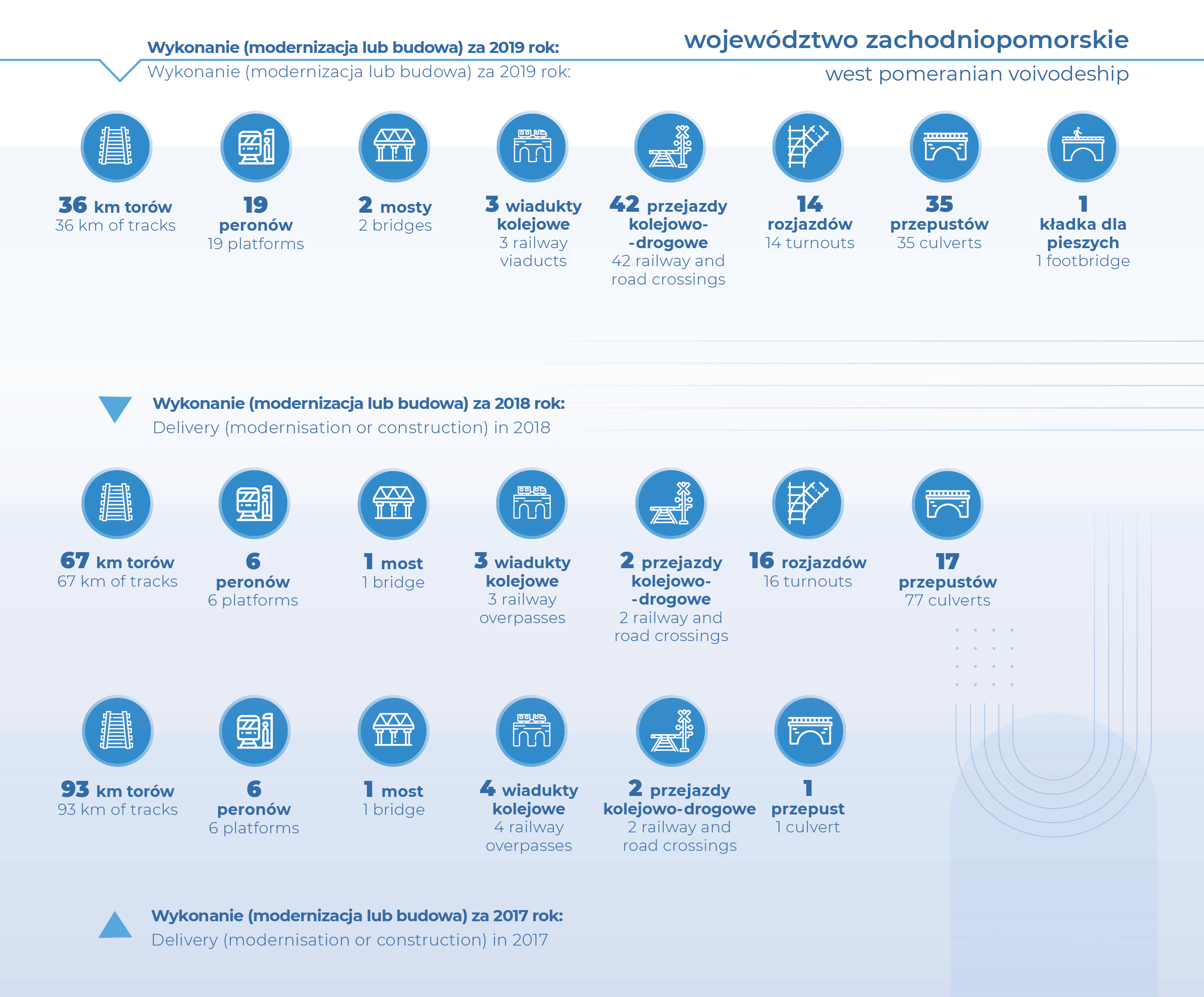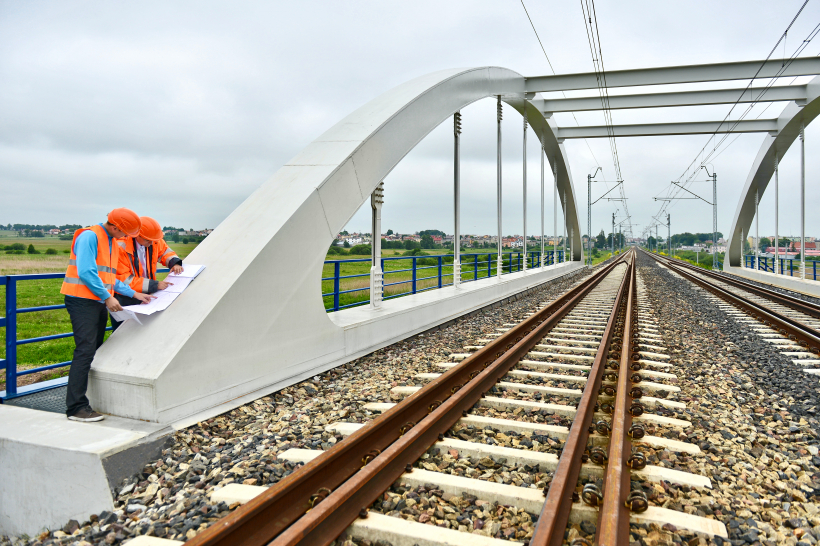
Modernisation works carried out by Trakcja PRKiI
Railways in Poland
29 grudnia 2020

Modernisation works carried out by Trakcja PRKiI
Financing
NRP assumes the maximum utilisation of EU funds on financing the projects under: Operational Programme Infrastructure and Environment (OPIE) for 2014-2020, Connecting Europe Facility (CEF), Operational Programme Eastern Poland (OPEP) for 2014-2020 and Regional Operational Programmes (ROP) for 2014-2020. Under the National Railway Programme, Poland will spend nearly PLN 76 billion on railway investment. Expenditure planned in addition to EU funds includes national public funds (from the state budget), own resources of the company and money from the issue of bonds. A significant source of expenditure financing is also borrowings from the European Investment Bank (EIB).
Assumptions
PKP PLK assumes continued modernisation and revitalisation of the existing railway network, including fast railway connections between the largest cities. The assumed transport speed will be 160 km/h for passenger connections and 120 km/h for freight trains. NRP is a considerable improvement to railway traffic in urban areas, enhanced travelling standard on regional routes and better goods transport conditions. The attractiveness of railways will be reinforced by a coherent railway network with higher speeds ensuring reduced travelling time in all regions, in interregional traffic and competitive freight transport, including between Silesia and sea ports such as the Tri-City, Szczecin and Świnoujście.
Thanks to newly built and reconstructed existing railway stops and the integration of railway and city transport, trains have become competitive to cars. Passengers can combine travelling by train, tramway, bus and metro. Thanks to additional tracks, facilities and modern equipment travelling time can be reduced and the number of trains can be increased. New transfer hubs and comfortable transport junctions are under construction, for example in Kraków, Warsaw and Gorzów Wielkopolski.
Travelling comfort
Travelling by rail begins on a comfortable railway station and stop. To this end, the existing facilities are under reconstruction and new ones are under construction throughout Poland. Sucha Beskidzka Zamek, Wólka Orłowska, Gorzów Wielkopolski Wschodni – these are new stops already used by passengers in Lesser Poland, Lublin region and Lubusz region. More stops are under construction, for instance in Warsaw, in Lower Silesia and in Lublin region. They will be available to everyone, equipped with roofs and seats, modern public announcement system and clear signage. A monitoring system will additionally increase safety. The modernisation of railway stations will also improve access. Platforms and underpasses are equipped with lifts and ramps and the signage is better and clearer. Thanks to this people with limited mobility, accompanied by children and carrying heavy luggage can reach the train easier. Guiding paths, touchable safety belts, railings and lifts with Braille markings facilitate passengers with poor sight and blind people moving around the station, reaching the ticket office and the train.
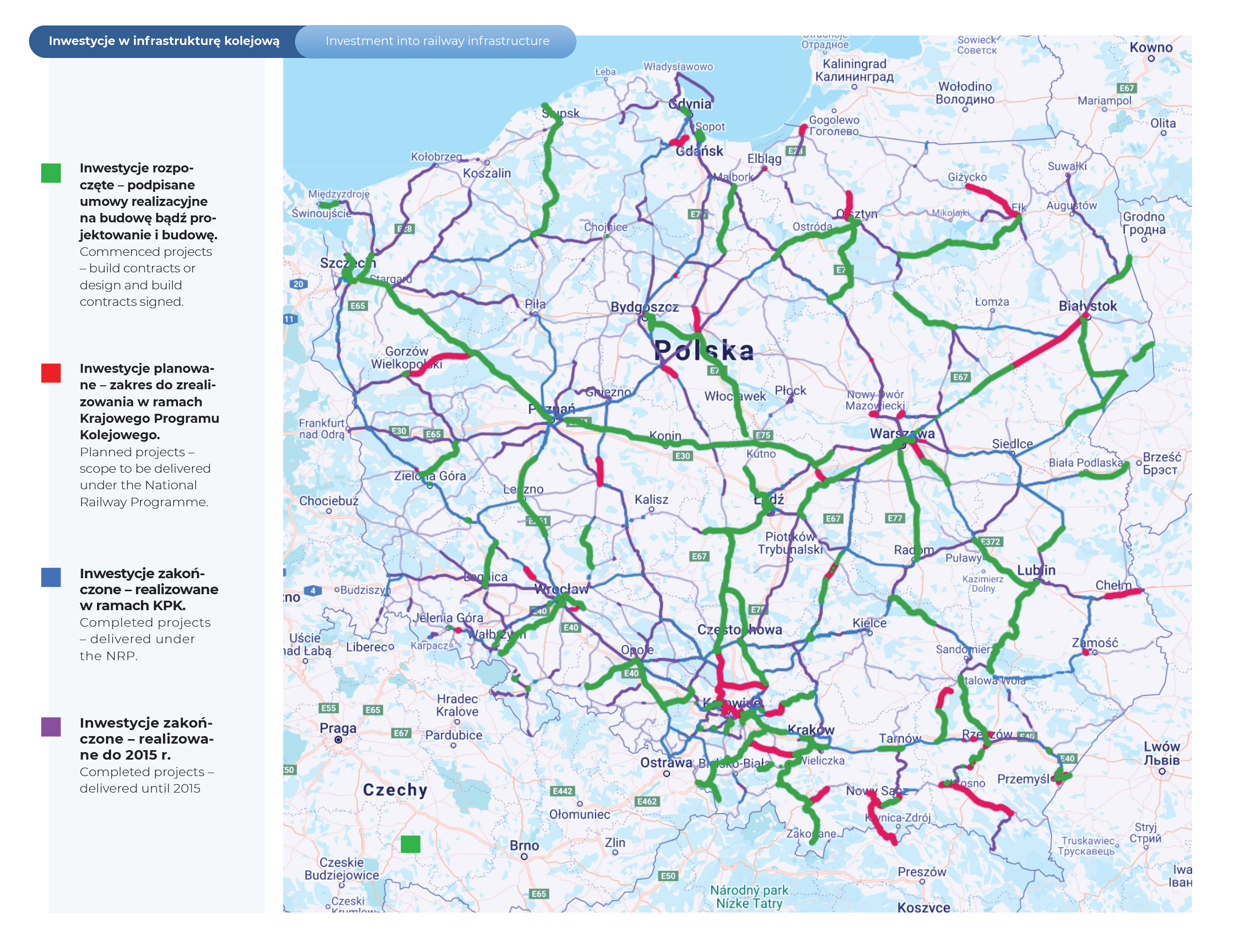
Facilitated transport
In the following years changes on railway lines will also improve freight transport standard. Modernised tracks will increase travelling speed for trains carrying coal, road construction aggregate materials, and container trains. New and reconstructed bridges and viaducts will gradually make the transport route smoother, free of speed limits and compensatory stops for instance for heavy trains. Better equipped stations with additional tracks guarantee efficient freight train service and timely arrivals and departures of urban transport and long-distance trains. Well-planned railway lines, modernised according to the environmental protection requirements, make railway a sustainable means of transport. Thanks to the use of special materials and erection of sound screens, new railway tracks reduce the noise cause by passing trains. Tracks are often a barrier to wild animals, so in order to avoid this, special animal crossings, so-called eco-ducts, are built above the tracks and migration routes are maintained next to bridges and culverts. Local control centres (LCS), equipped with computer systems and modern equipment, increase the efficiency and safety of traffic for a larger number of trains on the modernised lines. New turnouts are mounted – these are the elements of tracks ensuring smooth passage of trains through stations. The level of safety in railway and road traffic increases thanks to newly built railway crossings, underpasses and overpasses and a growing number of monitored road and tracks junctions equipped with crossing gates and signalling systems.
New directions
The National Railway Programme opens new travelling directions. Investments increasing railway network capabilities ensure fast access to locations and regions that are attractive to tourists. Rail links constructed in Kraków and Sucha Beskidzka and modernisation of the railway line to Zakopane gradually reduce the time of travel to Podhale and to the capital city of the Tatra Mountains. A modernised route between Tarnów and Muszyna will make travelling to the Beskid Mountains faster and more comfortable. In Lower Silesia we can comfortably travel from Wrocław to the Karkonosze Mountains in a short time. The effects of works on the Szczecinek-Ustka line encourage travelling by rail to the seaside.
Year 2019 was one of the most dynamic periods in the performance of the key NRP. The infrastructure manager intensified its activities both in connection with concluding new contracts, commencing construction works and accepting completed projects from contractors. The task completion scale was unique:
Construction works covered most of the territory of Poland and were especially intense in the south of Poland, in Masovia, Greater Poland and in West Pomeranian voivodeship. The investment projects not only lead to improvement of the operating parameters of railway lines such as maximum speed or permissible axle load. The modernisations to a large extent ensure compliance with the essential interoperability requirements specified in the TSI for subsystem 8. Intensive investment works entail a number of challenges related to maintaining the speed of the works, access to construction materials and economic and business conditions affecting contract value and timely performance.
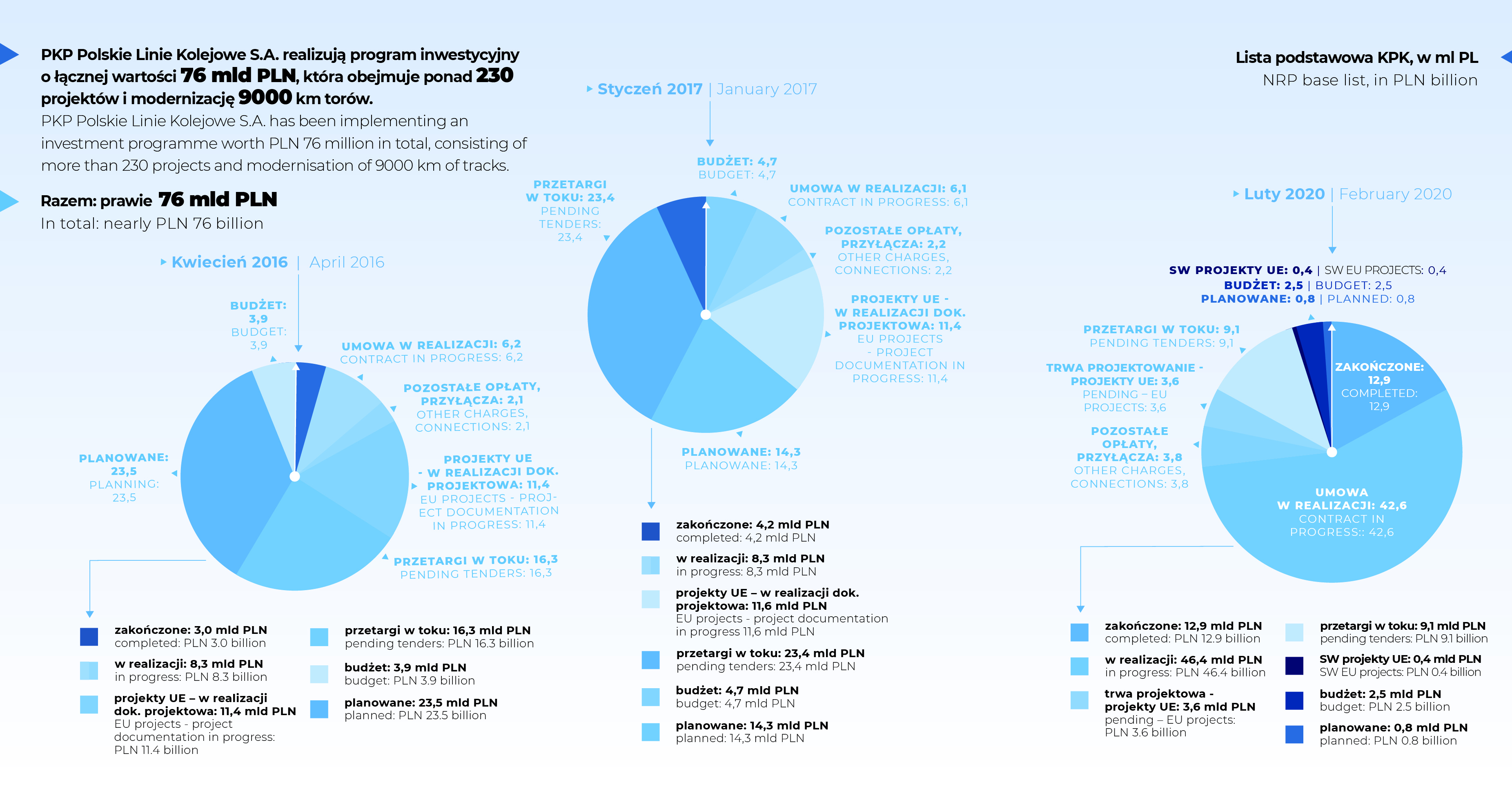
Numerous investment projects
Under the Investment Plan for 2018 more than 200 investment projects were adopted for completion. The most significant group were projects financed from the CEF and OPIE. The value of the completed plan exceeded PLN 9 billion. The objective scope of respective investment projects carried out by PKP PLK consists of comprehensive refurbishment of railway tracks, railway traffic control equipment and electrical power systems (catenary and other), as well as modernisation of one-level railway and road crossings and replacing them with two-level crossings. Under the plan, the railway network managed by PKP PLK, was covered by investment works including in particular modernisation, revitalisation or construction of, for instance, 1267.9 km of tracks, 380 crossings and 113 railway and road overpasses.
In 2019 the amount allocated to investment was PLN 10.5 billion:
Realizacje inwestycyjne w poszczególnych województwach:
LOWER SILESIAN VOIVODESHIP
In Lower Silesian voivodeship 1749.69 km of railway lines are in use, accounting for about 9.5% of the lines managed by PKP Polskie Linie Kolejowe S.A. The length of lines of national significance is 1046.32 km. Pursuant to the National Railway Programme, updated in July 2017, it is expected that 27 investment projects will be completed in Lower Silesian voivodeship by 2023 and their total value will be about PLN 2 billion.
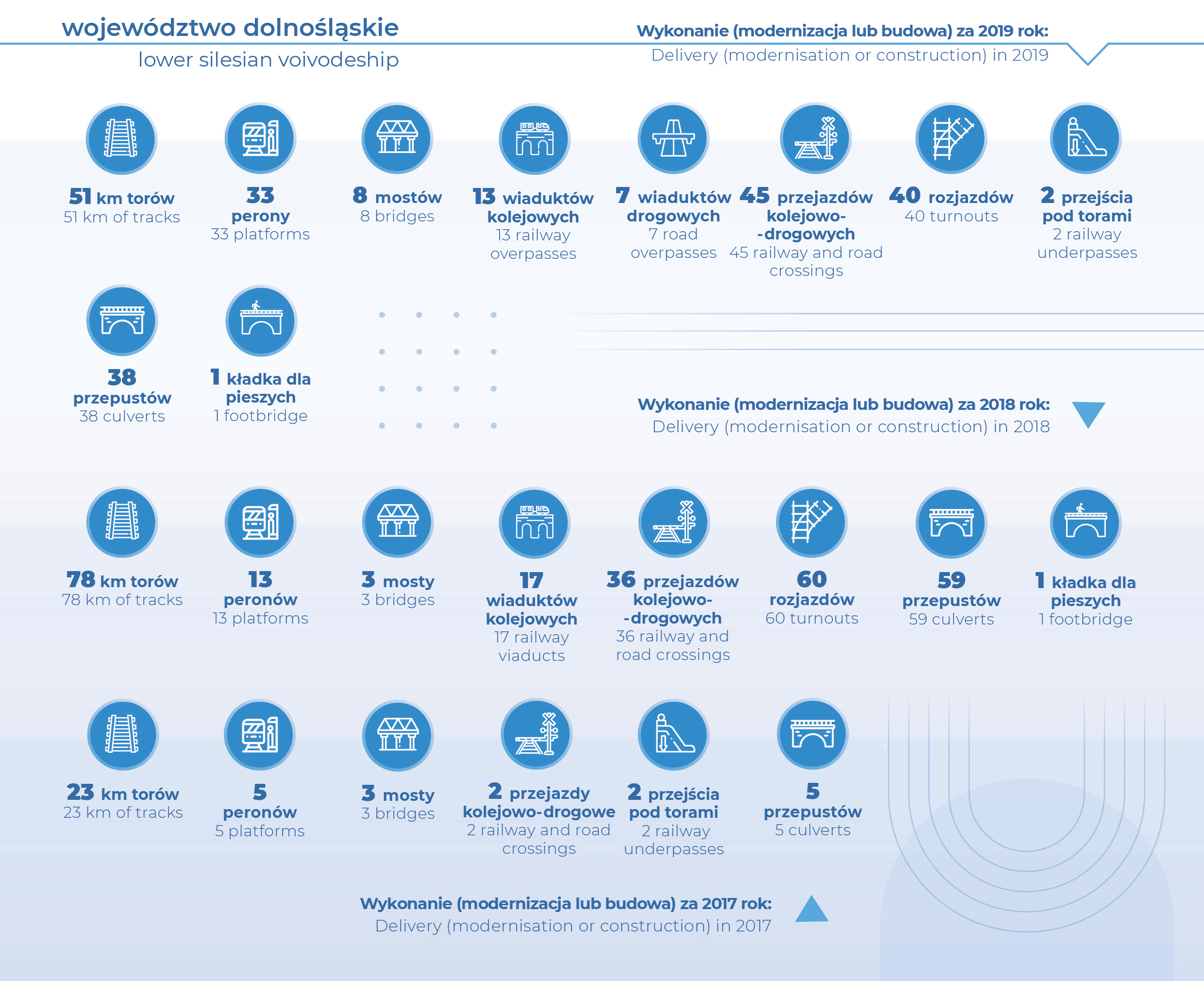
KUYAVIAN-POMERANIAN VOIVODESHIP
In Kuyavian-Pomeranian voivodeship 1199.41 km of railway lines are in use, accounting for about 6.5% of the lines managed by PKP Polskie Linie Kolejowe S.A. The length of lines of national significance is 839.86 km. Pursuant to the National Railway Programme, updated in July 2017, it is expected that 18 investment projects will be completed in Kuyavian-Pomeranian voivodeship by 2023 and their total value will be about PLN 1.5 billion.
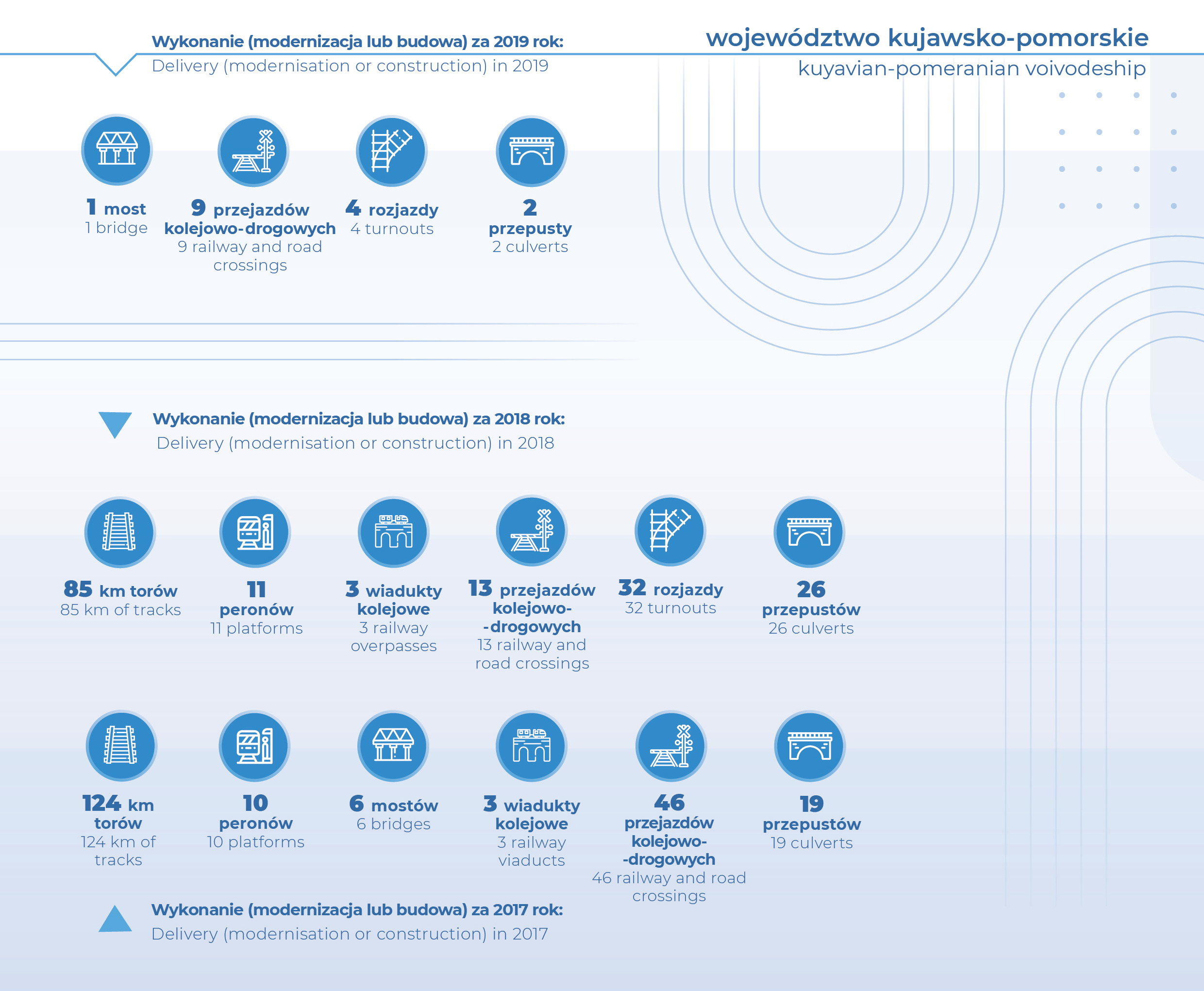
LUBLIN VOIVODESHIP
In Lublin voivodeship 924.19 km of railway lines are in use, accounting for about 5% of the lines managed by PKP Polskie Linie Kolejowe S.A. The length of lines of national significance is 480.81 km. Pursuant to the National Railway Programme, updated in July 2017, it is expected that 14 investment projects will be completed in Lublin voivodeship by 2023 and their total value will be about PLN 3 billion.
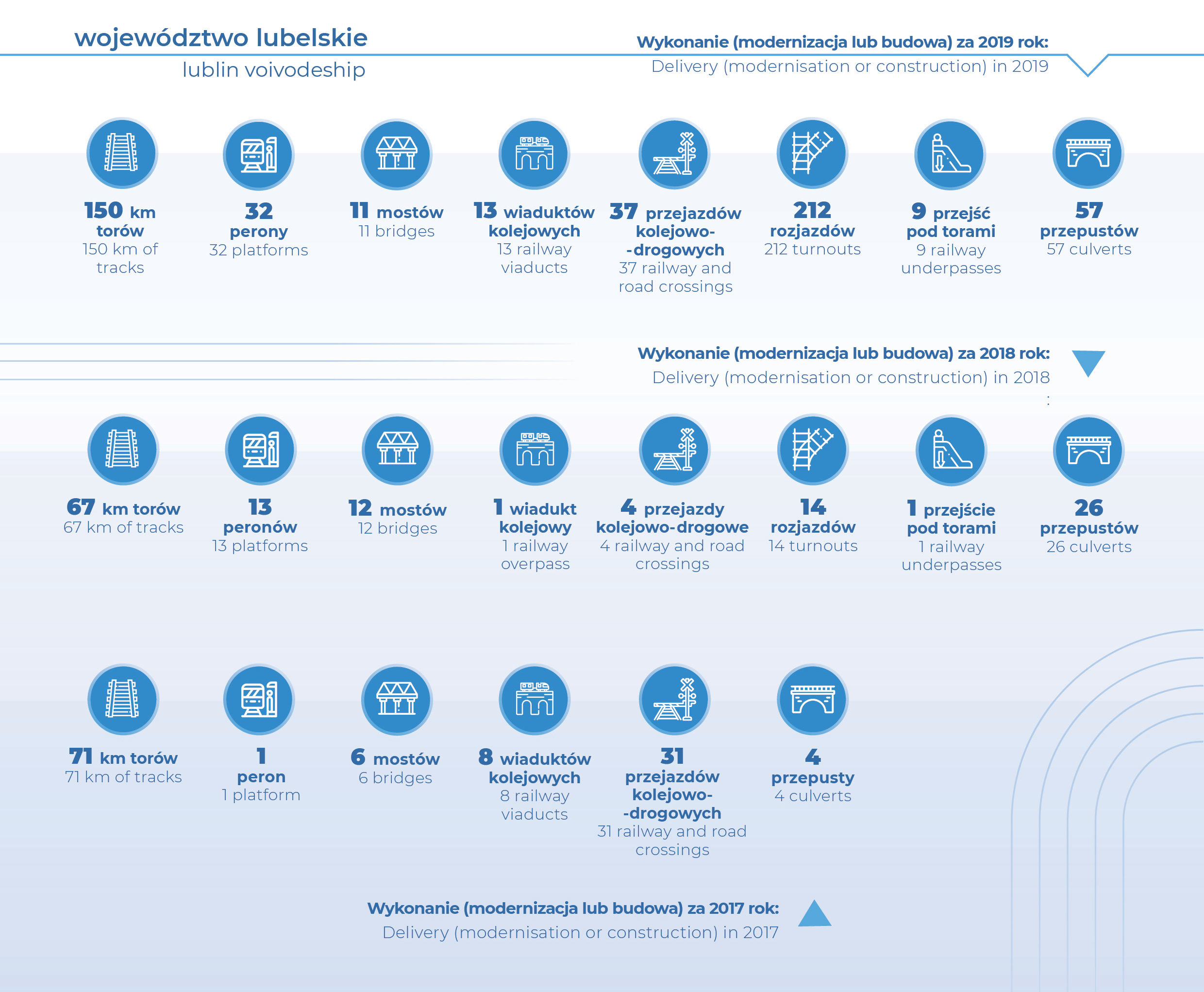
LUBUSZ VOIVODESHIP
In Lubusz voivodeship 889.64 km of railway lines are in use, accounting for about 5% of the lines managed by PKP Polskie Linie Kolejowe S.A. The length of lines of national significance is 642.97 km. Pursuant to the National Railway Programme, updated in July 2017, it is expected that 11 investment projects will be completed in Lubusz voivodeship by 2023 and their total value will be about PLN 0.5 billion.
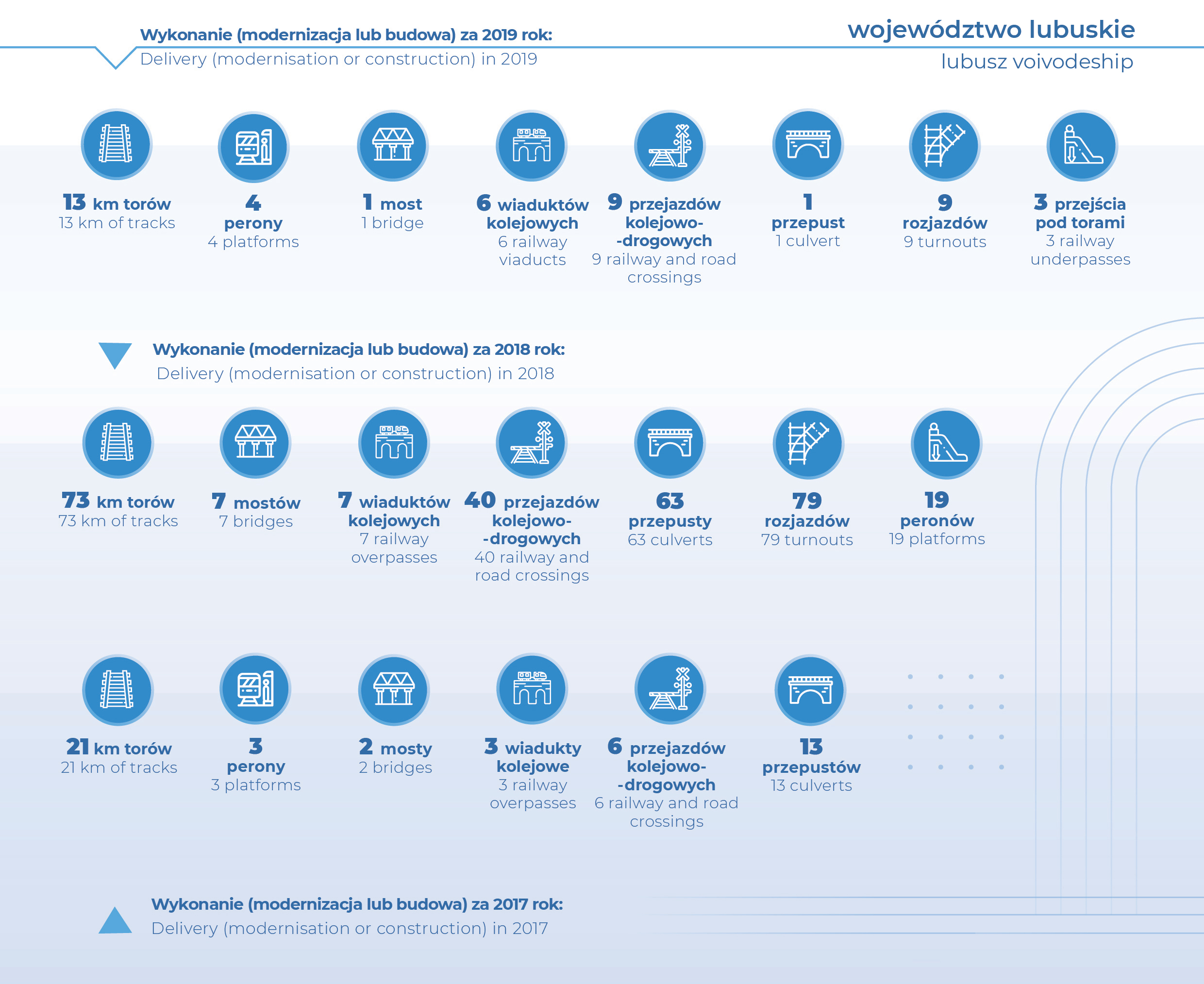
ŁÓDŹ VOIVODESHIP
In Łódź voivodeship 1080.25 km of railway lines are in use, accounting for about 6% of the lines managed by PKP Polskie Linie Kolejowe S.A. The length of lines of national significance is 889.76 km. Pursuant to the National Railway Programme, updated in July 2017, it is expected that 25 investment projects will be completed in Łódź voivodeship by 2023 and their total value will be about PLN 5.5 billion.
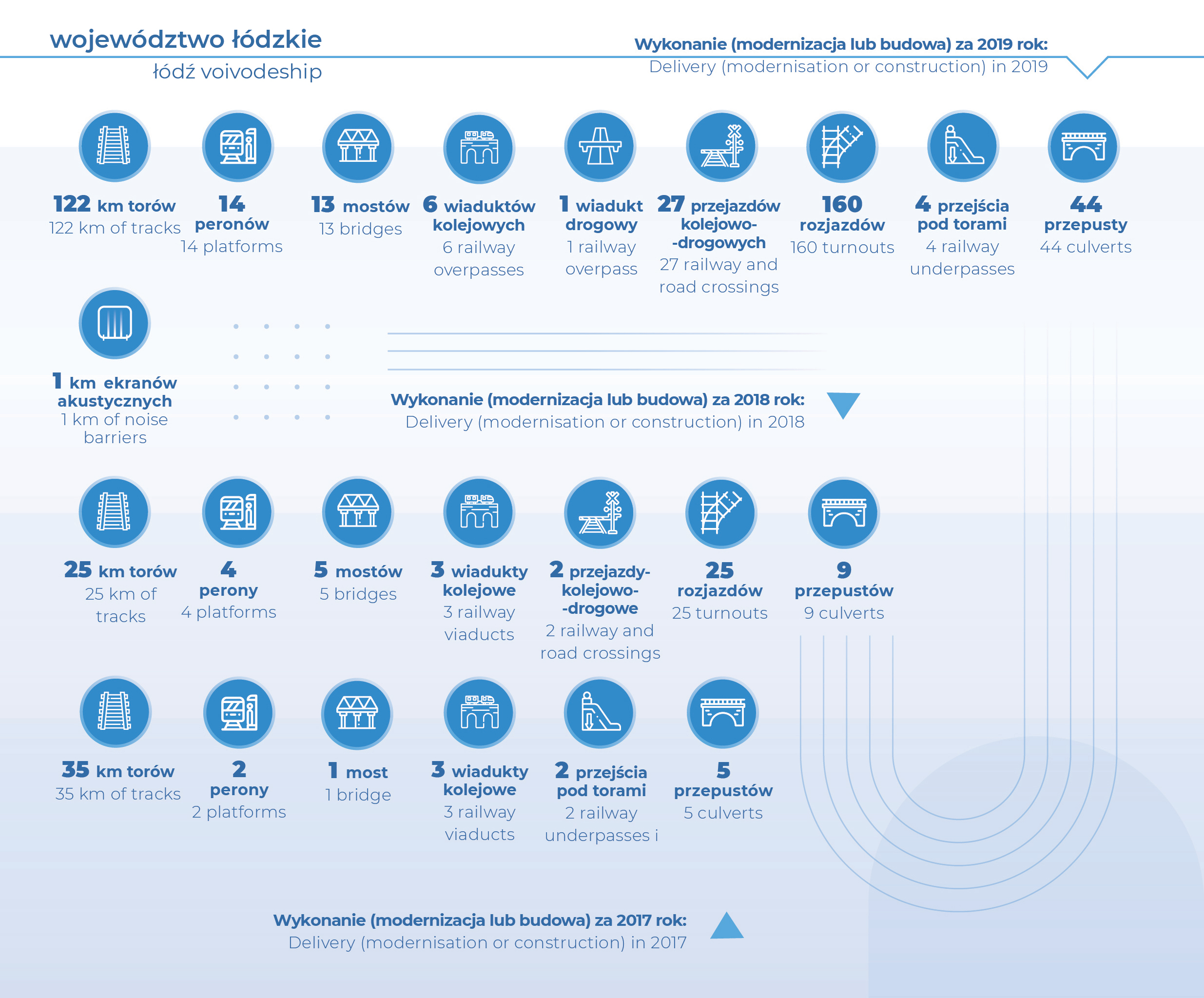
LESSER POLAND VOIVODESHIP
In Lesser Poland voivodeship 989.13 km of railway lines are in use, accounting for about 5% of the lines managed by PKP Polskie Linie Kolejowe S.A. The length of lines of national significance is 812.03 km. Pursuant to the National Railway Programme, updated in July 2017, it is expected that 26 investment projects will be completed in Lesser Poland voivodeship by 2023 and their total value will be about PLN 7.5 billion.

MASOVIAN VOIVODESHIP
In Masovian voivodeship 1676.47 km of railway lines are in use, accounting for about 9% of the lines managed by PKP Polskie Linie Kolejowe S.A. The length of lines of national significance is 1372.08 km. Pursuant to the National Railway Programme, updated in July 2017, it is expected that 34 investment projects will be completed in Masovian voivodeship by 2023 and their total value will be about PLN 8 billion.

OPOLE VOIVODESHIP
In Opole voivodeship 766.12 km of railway lines are in use, accounting for about 4% of the lines managed by PKP Polskie Linie Kolejowe S.A. The length of lines of national significance is 474.99 km. Pursuant to the National Railway Programme, updated in July 2017, it is expected that 14 investment projects will be completed in Opole voivodeship by 2023 and their total value will be about PLN 0.5 billion.
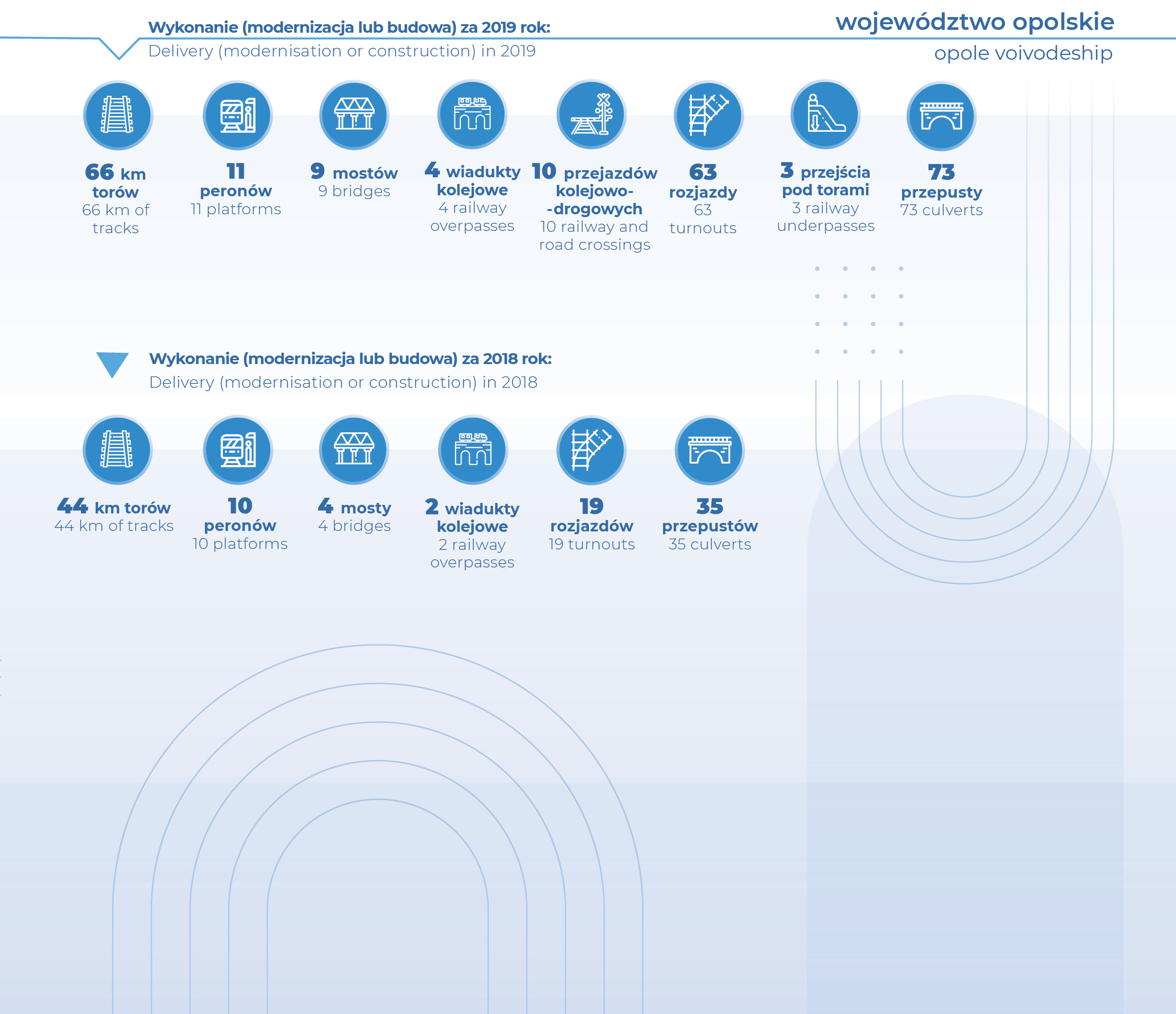
SUBCARPATHIAN VOIVODESHIP
In Subcarpathian voivodeship 894.83 km of railway lines are in use, accounting for about 5% of the lines managed by PKP Polskie Linie Kolejowe S.A. The length of lines of national significance is 390.49 km. Pursuant to the National Railway Programme, updated in July 2016, it is expected that 21 investment projects will be completed in Subcarpathian voivodeship by 2023 and their total value will be about PLN 1.5 billion.
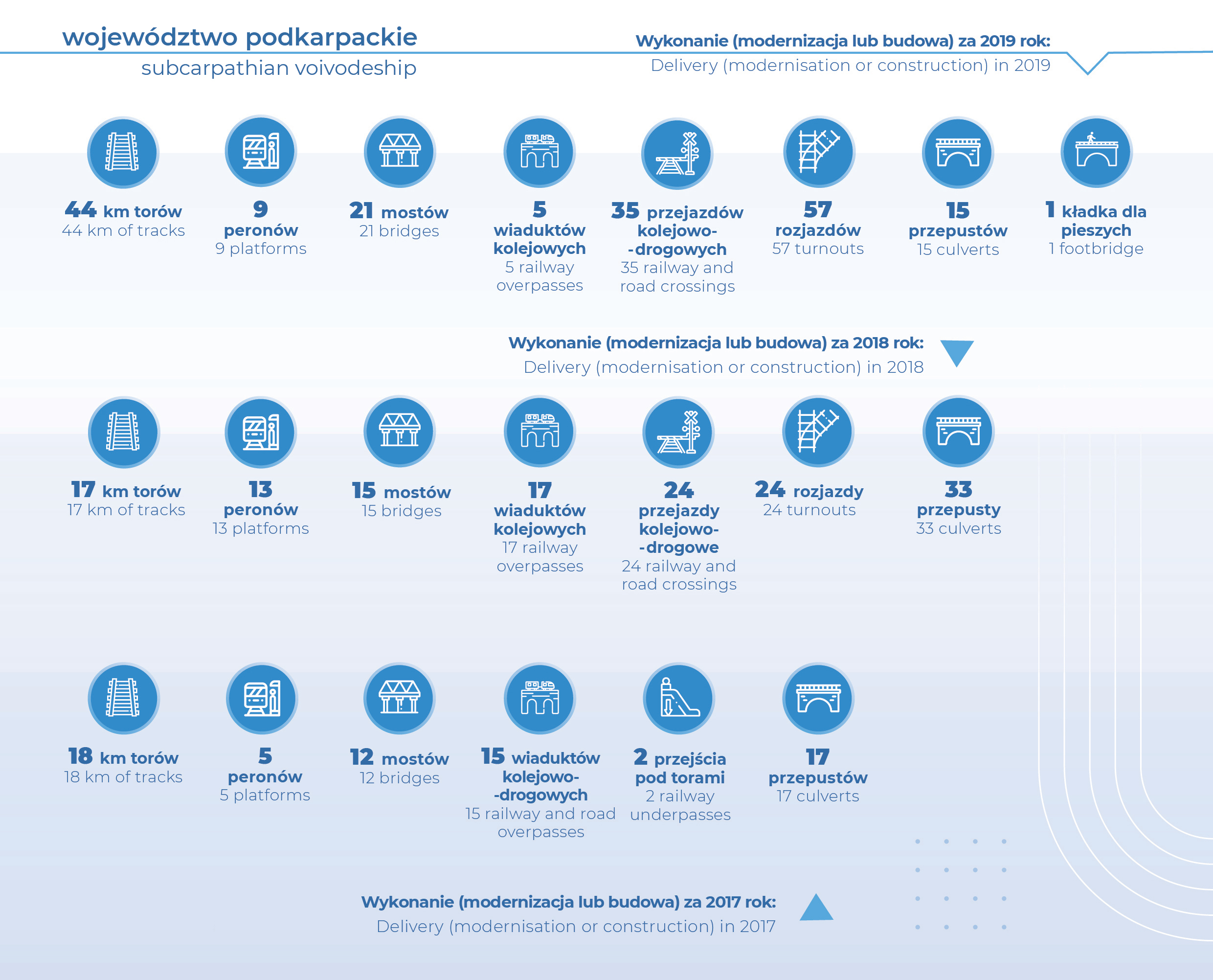
PODLASKIE VOIVODESHIP
In Podlaskie voivodeship 653.64 km of railway lines are in use, accounting for about 3.5% of the lines managed by PKP Polskie Linie Kolejowe S.A. The length of lines of national significance is 436.52 km. Pursuant to the National Railway Programme, updated in July 2017, it is expected that 16 investment projects will be completed in Masovian voivodeship by 2023 and their total value will be about PLN 2.5 billion.

POMERANIAN VOIVODESHIP
In Pomeranian voivodeship 1159.39 km of railway lines are in use, accounting for about 6% of the lines managed by PKP Polskie Linie Kolejowe S.A. The length of lines of national significance is 667.76 km. Pursuant to the National Railway Programme, updated in July 2017, it is expected that 16 investment projects will be completed in Pomeranian voivodeship by 2023 and their total value will be about PLN 6 billion.
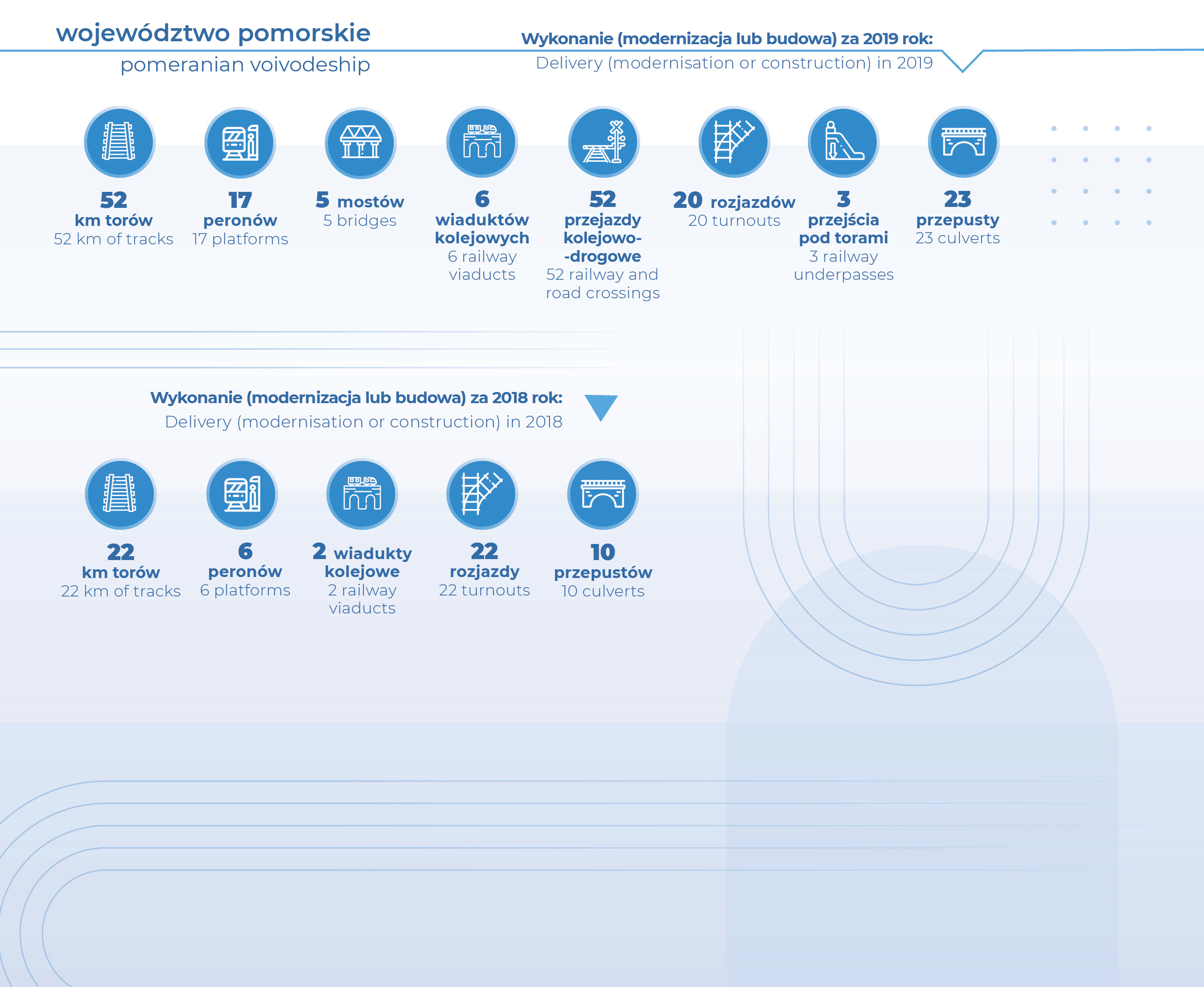
SILESIAN VOIVODESHIP
In Silesian voivodeship 1739.09 km of railway lines are in use, accounting for about 9.5% of the lines managed by PKP Polskie Linie Kolejowe S.A. The length of lines of national significance is 1287.93 km. Pursuant to the National Railway Programme, updated in July 2017, it is expected that 31 investment projects will be completed in Silesian voivodeship by 2023 and their total value will be about PLN 4 billion.
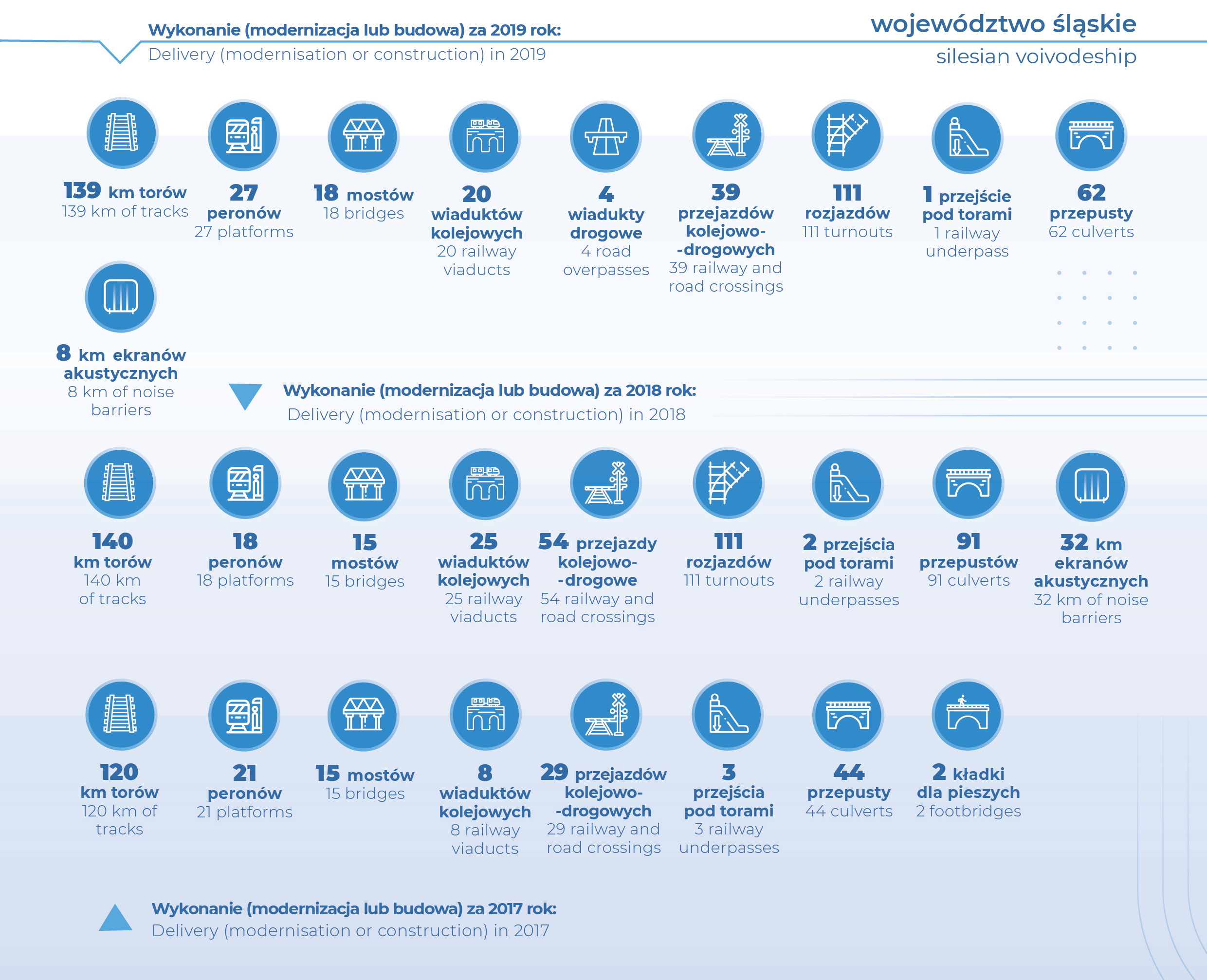
ŚWIĘTOKRZYSKIE VOIVODESHIP
In Świętokrzyskie voivodeship 601.23 km of railway lines are in use, accounting for about 3% of the lines managed by PKP Polskie Linie Kolejowe S.A. The length of lines of national significance is 428.52 km. Pursuant to the National Railway Programme, updated in July 2017, it is expected that 12 investment projects will be completed in Świętokrzyskie voivodeship by 2023 and their total value will be about PLN 1.5 billion.
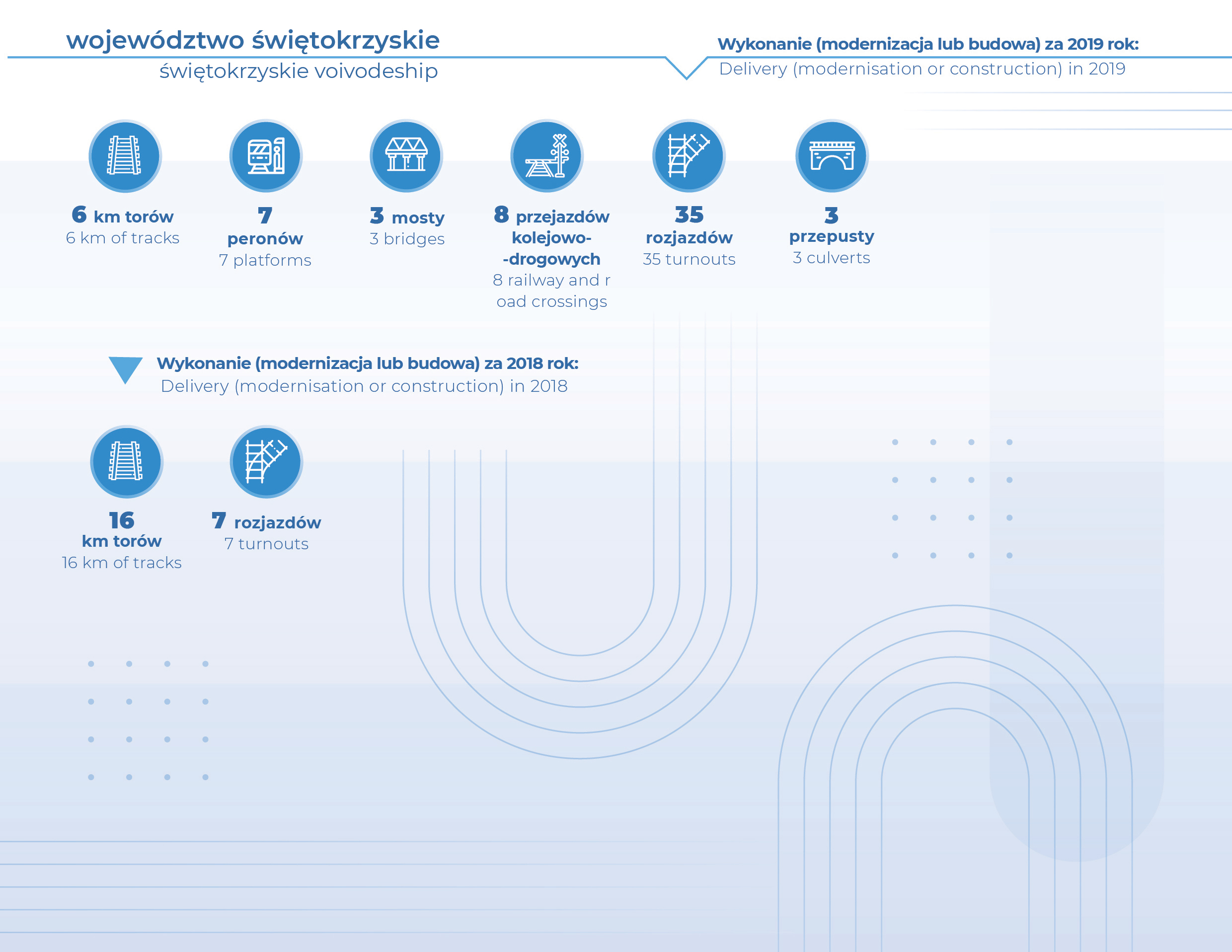
WARMIAN-MASURIAN VOIVODESHIP
In Warmian-Masurian voivodeship 1080.58 km of railway lines are in use, accounting for about 6% of the lines managed by PKP Polskie Linie Kolejowe S.A. The length of lines of national significance is 695.49 km. Pursuant to the National Railway Programme, updated in July 2017, it is expected that 11 investment projects will be completed in Warmian-Masurian voivodeship by 2023 and their total value will be about PLN 1.5 billion.
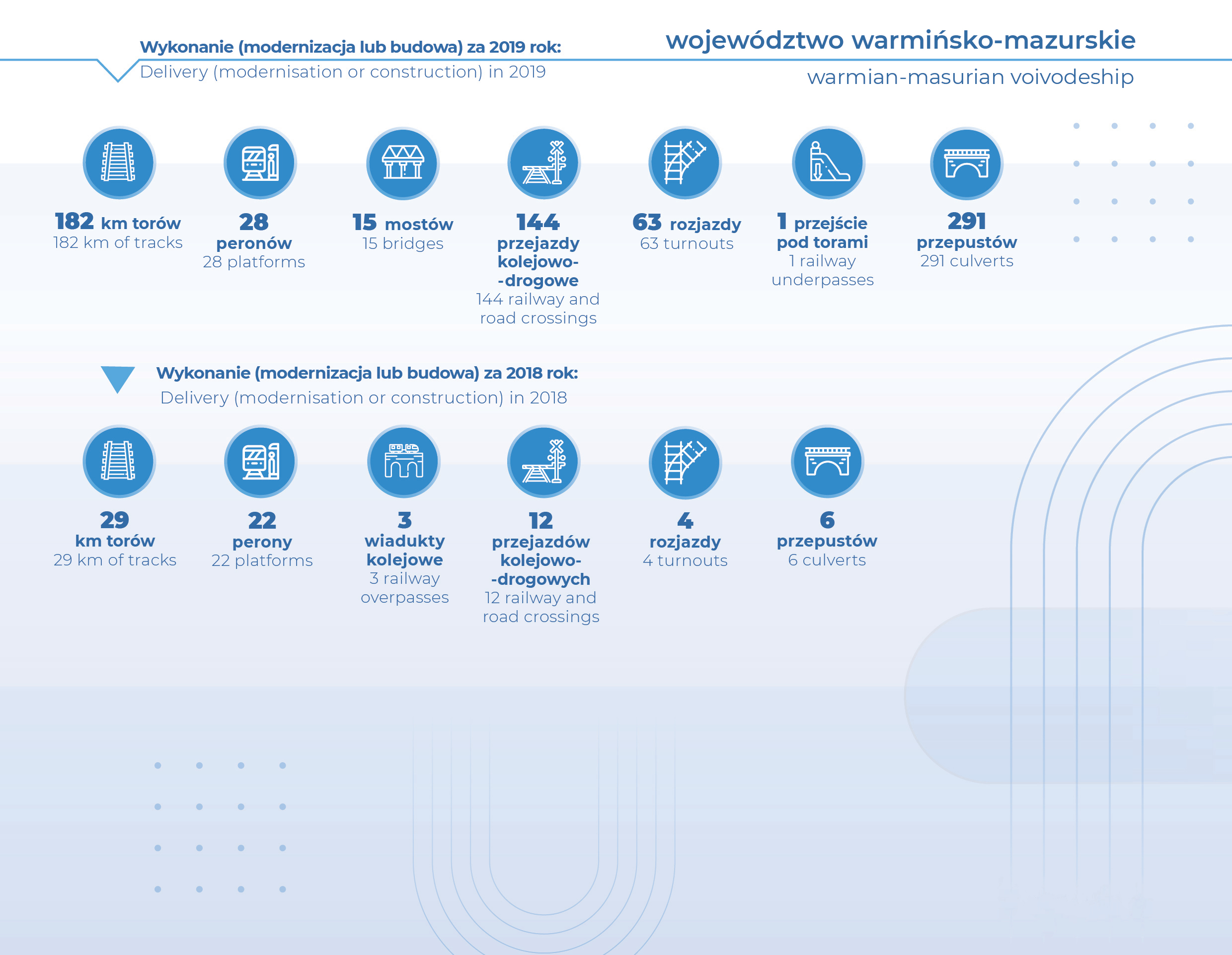
GREATER POLAND VOIVODESHIP
In Greater Poland voivodeship 1877.64 km of railway lines are in use, accounting for about 10% of the lines managed by PKP Polskie Linie Kolejowe S.A. The length of lines of national significance is 1128.9 km. Pursuant to the National Railway Programme, updated in July 2017, it is expected that 27 investment projects will be completed in Greater Poland voivodeship by 2023 and their total value will be about PLN 5.5 billion.
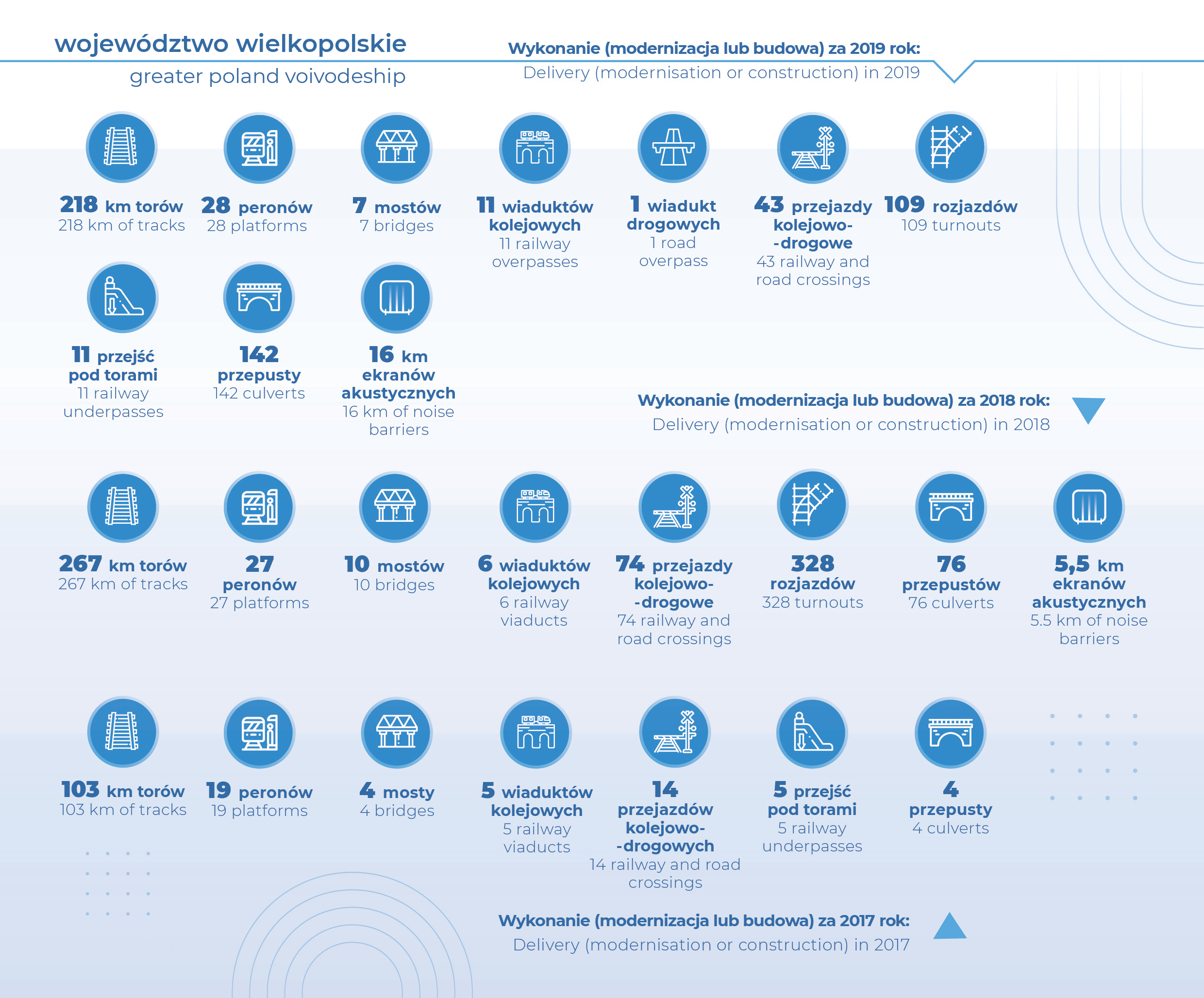
WEST POMERANIAN VOIVODESHIP
In West Pomeranian voivodeship 1147.65 km of railway lines are in use, accounting for about 6% of the lines managed by PKP Polskie Linie Kolejowe S.A. The length of lines of national significance is 782.03 km. Pursuant to the National Railway Programme, updated in July 2017, it is expected that 11 investment projects will be completed in West Pomeranian voivodeship by 2023 and their total value will be about PLN 2.5 billion.
